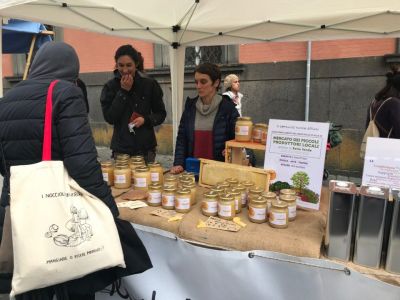La coltivazione dei noccioleti è uno dei settori italiani di eccellenza a livello mondiale, in un mercato in continua crescita. L’Italia rappresenta oggi il secondo produttore globale dietro solo alla Turchia ed ha un grande potenziale di sviluppo grazie ad un territorio che, da nord a sud, è particolarmente adatto alla coltivazione di eccellenti varietà. Ad oggi in Italia vengono dedicati migliaia di ettari di terreno alla coltura delle nocciole, con progetti in atto per creare le condizioni per una concreta opportunità di riconversione e valorizzazione di ampie superfici del nostro territorio, incrementando ulteriormente la produzione nel nostro Paese dell’ ingrediente di punta della Nutella, ma dando luogo, al contempo ad una nuova controversia.
A growing movement in Umbria and nearby Latium is set on blocking the conversion of farm lands to the cultivation of hazelnuts.
Converting the use of land is disastrous for the many small farmers who rent acreage from large land-owners. Hazelnut farming is a much more lucrative business, especially to those who own large spans of land in the area. Small farmers are finding themselves pushed out of rental land for the planting of more trees which grow the popular nut.
Mass cultivation of hazelnuts would also alter the varied landscapes of central Italy. Forests, shrubs (that beautiful yellow broom) and wildflowers – it’s hard to imagine a landscape without poppies – would give way to plowing for hazelnut groves.
Fertilization and increased water usage in hazelnut mass cultivation both underscore il nocciolo del problema, or the heart of the matter. Chocolate industries around the world need hazelnuts. In fact, Italy is second only to Turkey in production. Nutella, Ferrero, Venchi (of Piedmont), Socado in the Veneto region, as well as Belgian chocolates all feature hazelnuts in many of their products. Of course, the Umbrians savor the goodness of Perugina chocolates (once owned by the Spagnoli family of Perugia and now by Nestlé in Switzerland) of which a favorite dark chocolate bar highlights hazelnut.
Cultivation is destined to increase but a grassroots movement in Umbria and Latium to halt massive monocultura of the hazelnuts has taken off. In early March, proponents of biodiversity – many of them local farmers with small landholdings or rented land – met in Orvieto at an all-day event, I Noccioli del Problema, to learn more about monoculture’s impact on the land. The mayor of Orvieto opened the morning convegno and speakers included environmentalists and university science professors. A prime proponent of the project, Alice Rohrwacher, an Italian film director, was a principal organizer of the event. Her parents cultivate land not far from nearby Lake Bolsena in Latium.
Part of the event was a buffet lunch in the atrium of the palazzo with all the tasty dishes cooked up by some of the farm families present. Local farmers also sold their goods in Orvieto’s majestic 13th century Palazzo del Popolo: honey, olive oils, wines, fresh eggs, vegetables, jams and sauces from their fruit trees, cheeses of their goats and sheep, breads and pies from their wheat and farro were available for sale.
While Umbria and its people understand the financial appeal for more hazelnut groves, the vast majority, especially those in attendance at the “il nocciolo del problema” event, can’t imagine altering the beauty all around them.
https://www.lagazzettaitaliana.com/food-and-wine/9085-hazelnut-farming#sigProId3eb5d9eb82




